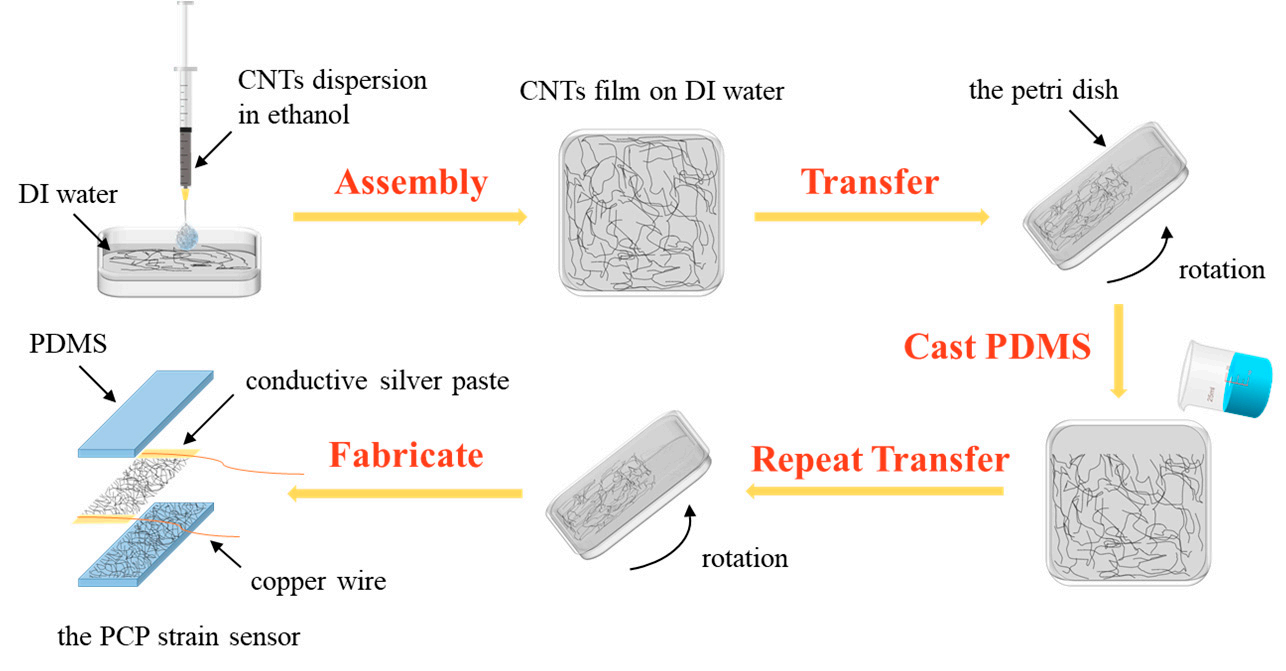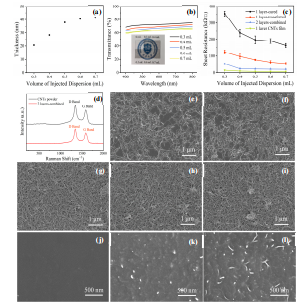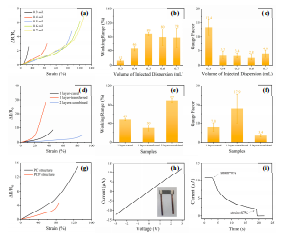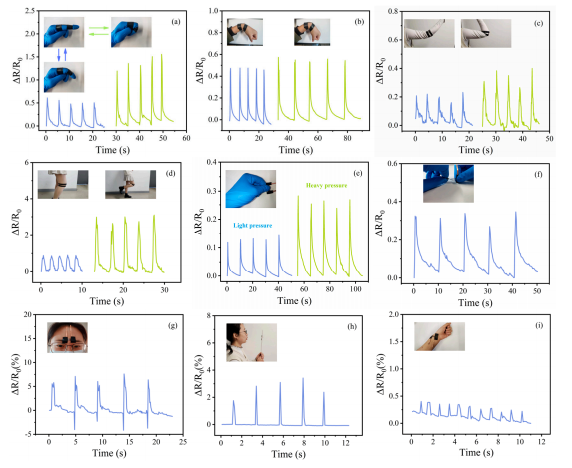Abstract: The Marangoni effect has been applied in the preparation of large-area ultrathin films. However, defects occur frequently during the transfer progress of ultrathin films to substrates, which limits its application in scalable and massive fabrication. Carbon nanotubes (CNTs), as typical one-dimensional carbon materials, are widely used in wearable and flexible sensors due to their outstanding electrical and mechanical properties. In this paper, Marangoni-driven self-assembled CNTs film was obtained by injecting 0.5 mL 1 mg·mL−1 CNTs/ethanol dispersion on 100 cm2 water dropwise; the thickness, sheet resistance, and optical transmittance (at 550 nm) of the as-prepared ultrathin film were 38 nm, 7.3 kΩ/ , and 66.9%, respectively. The CNTs film was transferred onto polydimethylsiloxane (PDMS) to prepare a conductive composite of CNTs/PDMS film and the sheet resistance of the composite film reached 21.0 kΩ/ . Furthermore, the packaged PDMS/CNTs/PDMS (PCP) strain sensors with a sandwich-like structure exhibited satisfactory sensitivity with a gauge factor of 3.4 at 50% strain, a large working range (89%), and excellent stability (>8000 cycles). The easy-making and low-cost sensors show great potential in wearable electronics, real-time motion detection, and electronic skin.
1. Introduction
Strain sensors are devices that convert mechanical strain into electrical signals. With the rapid development of electronic devices, flexible and stretchable strain sensors have acquired widespread attention among researchers. According to their signal transition mechanism, strain sensors can be generally divided into resistive, capacitive, piezoelectric, inductive, magnetic, and other types. Among them, resistivetype sensors are widely favored because of their simple structures, wide working ranges, high sensitivity, stable signal output, and simple signal reception. Typically, resistivetype sensors are composed of electrically conductive materials and flexible substrates. Conductive materials play an important role in constructing a conductive network and generating resistance change under strain. However, these conductive materials are difficult to use as strain sensors by themselves because of their tiny size and discontinuity. The insulating flexible substrates not only show the function of supporting and connecting conductive materials, responding to stress and strain, but also make crucial contributions to the flexibility and stretchability of sensors. The cooperation of conductive materials and flexible substrates increases the working range and stability of sensors significantly. The sensing mechanism of resistive-type flexible strain sensors is that the electron transport paths change due to the destruction and reconstruction of the conductive network under strains, or the contact resistance and tunneling resistance change due to the displacement of the conductive nanomaterials. When the sensor is stressed, even minor strain will lead to its electrical resistance changes and, after the stress is released, both the strain and resistance of the sensor will return to the initial status. In addition, strain sensors can also be roughly classified according to their structures, such as full-filled, sandwichlike, and absorption-structured sensors. A classical sandwich-like sensor can be fabricated by clamping the conductive film with two layers of flexible substrates. The sensors with a sandwich-like structure, owning high sensitivity and stability, have received extensive attention. As the “nerve endings” of the Internet of Things, the flexible strain sensors are the key components of smart devices and wearable electronics, which have a wide range of applications in human-computer interaction, electronic skin, health monitoring, and so on.
2. Materials and Methods
Fabrication of CNTs film. A certain volume of CNTs/ethanol dispersion (1 mg·mL−1 ) was added dropwise onto the surface of 100 cm2 DI water in a plastic square Petri dish, and an assembled CNTs film immediately formed on the DI water surface. The matching lid was put on the Petri dish closely and then the Petri dish was flipped carefully so that the CNTs film was transferred onto the lid. The interfacial assembly of CNTs film is demonstrated in Supporting Movie S1.
Fabrication of composite conductive film. Liquid PDMS and its curing agent were mixed at a mass ratio of 10:1. The mixture was placed into a vacuum drying oven for 0.5 h to remove the bubbles; thereafter, it was cast onto the dried CNTs film and spun at 300 r·min−1 on the spin coater. After heating at 45 ◦C for 4 h, PDMS mixture was cured together with CNTs film. The obtained CNTs/PDMS film was turned over gently on the lid and we transferred another CNTs film onto a CNTs/PDMS film directly as mentioned above to increase electrical conductivity.
Fabrication of sandwich-like PCP strain sensors. Copper wires were drawn by conductive silver paste at both ends of the conductive layer to form electrodes. The width of the conductive layer was 0.8 cm and the distance between the two electrodes was about 2 cm. In the final step, an additional layer of PDMS was cured on the top of conductive film to protect the copper wire joints and form a sandwich-like structure. We call this resulting sensor a PCP strain sensor in this paper. For clarity, a schematic diagram for the fabrication procedures of the PCP strain sensor is presented in Figure 1.

Figure 1. Fabrication procedures of the PCP strain strain.
3. Results and Discussion
A certain volume ot l mgmLCNls/ethanol dispersion was injected onto thesurface of DI water dropwise. The CNls/ethanol dispersion diffused on the surface ofthe water rapidly, which motivated the CN'Ts to move and form a continuous film on thewater instead of sinking into the water (as shown in Supporting Movie S1). As the volumeof the injected dispersion increased, the tightness of the CNls film gradually increasedwhich can be demonstrated by Figure 2a,e-i and Supporting Movie S1. The thickness ofthe CN'Ts film is not linearly related to the volume of the CNTs/ethanol dispersion. Whenthe drop-on volume increased frm 0.3 mL, to 0.5 mL, the thickness of the CN'Ts film hadgrown fmm 21 nm to 38 nm, mainly due to the increased tightness between the CNTsAs the volume further increased to a critical point, the CNIs had completely covered thewater surface and the compactess of the CNls film was close to saturation. The surplusCN'Ts sunk to the bottom of the water so that the thickness of the CNTs film was almostunchanged. The CNTs films prepared with Marangoni self-assembly showed good opticaltransparency, as shown in Figure 2b. The optical transmittances at 500 nm of the filmsformed with 0.3 mL and 0.5 mL dispersion are 72.3%, 66.9%, respectively. Even with amaximum volume of 0.7 mL, the transmittance of the film can still reach 62.6%. In additionthis kind of self-assembly film has superior electrical conductivity. The sheet resistances ofthe CN'Ts films assembled by 0.3 ml and 0.5 mL dispersion are 13.9 kΩ/ and 7.3 k/respectively, as shown in Figure 2c.

Fig2
In order to improve the conductivity of the CNTs/PDMS composite films, the Marangonidriven ultrathin CNTs films can be transferred repeatedly to the surface of the composite film. The sensors loaded with two layers of the CNTs film were named as “2 layers combined” film, whose sheet resistance was 21.0 kΩ/ . It was confirmed by the Raman characterization in Figure 2d that the two layers-combined film was composed of a dense network of high-quality CNTs. The value of ID/IG reflects the defect degree of the sample. The higher the value of ID/IG, the more defects the sample contains and the more irregular the structure. The ID/IG values of the CNTs powder and two layers-combined film are 1.29 and 1.33, respectively, and the similar values mean a dense network of high-quality CNTs has been formed in the two layers-combined films.
Figure 3d–f demonstrates that the strain sensors obtained by the different conductive films exhibit different electrical properties. The three kinds of sensors we fabricated are, respectively, named “1 layer-cured”, “1 layer-transferred”, and “2 layers-combined”, corresponding to the name of the conductive films. The “1 layer-transferred” sensor exhibits the highest sensitivity and the most limited working range due to its small content of CNTs and the penetration degree of the PDMS into the CNTs networks, which leads to resistance changes substantially with strain. Compared with the “1 layer-transferred” sensor, the “1 layer-cured” one has a wider working range and smaller sensitivity, which is attributed to a higher penetration degree of the PDMS into the CNTs networks. Among the three sensors, the “2 layers-combined” sensor is the one with the best conductivity due to having the highest CNTs content, largest working range, and smallest GF. In consideration of the conductivity and working range, the “2 layers-combined” sensor is more suitable for practical application in detecting large strains.

Fig3
The PCP strain sensors we designed can be used to detect various body motions based on these excellent performances. With the help of tapes, they can be adhered to various joints of the human body because of their soft and flexible characteristics.
As shown in Figure 5a, the sensor could detect the bending of the finger preciselyWhen the finger adjusted from 0° to 45°, R/R, increased from 0 to about 0.6, and thenAR/Ro recovered to 0 as the finger joint returned to 0°. When the finger was bent todifferent degrees, the resistance changes were also different. After the sensor was bentand released several times, the sensing signal was still clear and stable. Additionally, weattached PCP strain sensors onto the tester's wrist, elbow, and knee to monitor the motionofbending, shown in Figure 5b-d. The sensors responded differently in resistance changewhen the joints were bent to different degrees and the different joints also corresponded todifferent electrical responses.

Fig5
In this paper, we designed a high-performance flexible strain sensor with a simplestrategy. A single layer of CN'Ts film was self-assembled in a few seconds due to theMarangoni effect. The tightness and thickness of CN'Ts film are adjustable within the limitsby controlling the injected volume of the CNTs/ethanol dispersion. The CNTs film obtainedby the 0.5 mL 1 mg:mL-CNTs/ethanol dispersion on 100 cm? water exhibits a thicknessof 38 nm, a sheet resistance of 7.3 kΩ/,and optical transmittance at 550 nm of 66.9%respectively, After transferring the CNTs film to PDMS twice and packaging it with PDMSwe obtained the sandwich-like PCP strain sensors. The content of the CNls (including theinjected dispersion volume and the layer counts of CNTs film attached to PDMS) and thefabricating structure of sensors have an enormous influence on the sensing property. Thetypical PCP sensors show satisfactory sensitivity (GF = 3.4), a large working range (89%)and excellent cyclic stability (>8000 cycles). In addition, they perform outstandingly insensing tensioning, bending, pressing, and twisting. The experimental results indicate a remarkable potential for the PCPstrain sensors to apply in human motion detection andelectronic skins.
下一篇: 氧化石墨烯分类与标准化